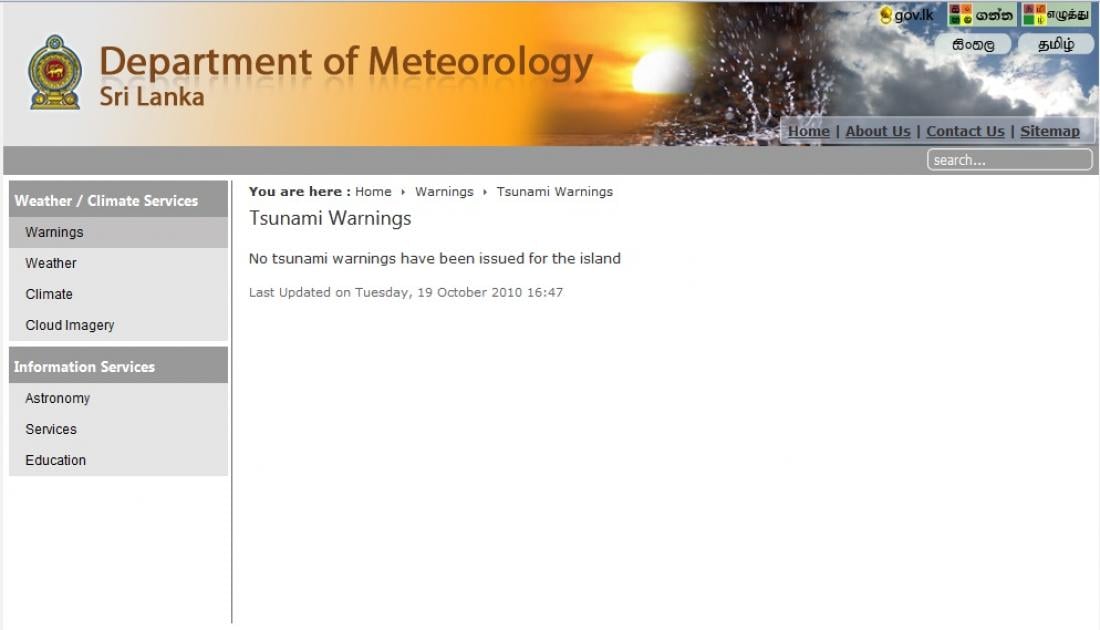Screen shot of Department of Meteorology website, taken as 1035Z (1605 local time)
Rohan Samarajiva
Chair and CEO, LIRNEasia
12 Balcombe Place, Colombo 00080, Sri Lanka.
E-mail: [email protected]
Mobile: +94 77 735 2361
Fax: +94 11 267 5212
www.lirneasia.net
In theory, national governments should issue tsunami watches and warnings. For sure, they should be the only ones issuing evacuation orders. But social media are upending government control.
Sri Lanka is not located in an earthquake zone. So when those of us who felt the tremors, our first reaction was to doubt our senses. People texted each other to verify. In my case, I learned that the tremor I felt was caused by an earthquake from a tweet within 10-15 minutes of the event. My first reaction was to check the magnitude and depth of the quake from the best scientific source I knew: the United States Geological Service. My first tweet, based on confirming the event at the USGS site, was at 1429 local time (20 minutes after the earthquake)
I sent several tweets, sticking pretty closely to USGS data. Unlike in 2004, the phones were working (within networks, though performance was patchy in locations, especially near the coast line) and Internet was not slowed down noticeably. Calls from one network to another were subject to congestion delays, suggesting that the interconnection links had been inadequately dimensioned.
Tweets kept flying. I and several others active in social media kept emphasizing that only a “watch” existed, that people should be alert and not do anything for now.
I even stuck my neck out and said that given the depth, it was unlikely that a tsunami would be generated. Even though the 2012 earthquake occurred in deep ocean much further away from Aceh than in 2004, I felt that the key would be reports from Aceh and kept checking for reports. None could be found. Only official news of a moderate tsunami came from Pacific Tsunami Warning Center’s Bulletin #3 (at 1014Z, more than 90 mts after the earthquake).
I projected arrival times in Sri Lanka based on the USGS model in a tweet sent at 1449 local time (40 minutes after the event).
Table 1: Sri Lanka projected arrival times for 11 April 2012 tsunami (if one occurs); local times inserted in parentheses
SRI LANKA TRINCOMALEE 8.7N 81.3E 1049Z (1619 local time)
DONDRA_HEAD 5.9N 80.6E 1054Z (1624) 11 APR
COLOMBO 6.9N 79.8E 1121Z (1751) 11 APR
JAFFNA 9.9N 80.0E 1235Z (1805) 11 APR
Source: http://ptwc.weather.gov/ptwc/text.php?id=indian.TSUIOX.2012.04.11.1014
Government response
-------------------------------
People were checking government sources. One tweeted that the Department of Meteorology website was silent on the subject. I checked within an hour of the quake: it had been last updated 19 October 2010. The screen shot below was taken even later at 1605 local time (1035 Z). The official warning and evacuation order came at 1630 (1100 Z). That was AFTER the model’s predicted arrival times for southern and eastern Sri Lanka.
Figure 1: Screen shot of Department of Meteorology website, taken as 1035Z (1605 local time)
Meanwhile, trains were stopped on the coastal line. Electricity supply was shut down in certain areas. Buses were stopped. Offices were closed and people asked go home. It was a disorganized random set of responses uninformed either by realistic assessments of the risk (exemplified by the model predicting arrival times) or by definitive guidance from the government. One could not entirely blame the government, because decisions to close offices early were taken without any coordination by individuals. No thought appeared to have been given to the vulnerability of those expelled from their workplaces and onto congested roads. The opening of the toll gates on the Southern Expressway to accommodate those who did not want to or could not use the coastal road was praiseworthy.
Conclusions
------------------
Whatever the theory says, social media and the Internet have changed the conditions of warning irrevocably. Social media appear to be disseminating information about impending hazards extremely fast. The government looks even more inept in these conditions, when they wait for too long to issue (unnecessary) evacuation orders. It is even more important in these conditions to improve internal processing of information and decision making so that the government can issue unambiguous directives based on the best science available.
Even more important is the education of various authorities such as those running the trains, supplying electricity, etc. about the appropriate responses. Those responsible for schools, offices, hotels, exhibitions, etc. should be educated and if necessary directed to desist from rash closures and suspensions. Offices, especially high rises, are safer than a congested road should a tsunami come.
The government’s assertion that tsunami warnings worked is dubious. It is true that most people knew about the potentially tsunamigenic earthquake within an hour of its occurrence, which from the perspective of avoiding loss of life is very good. However, it is doubtful whether the government can claim credit for that awareness. When it came to issuance of warnings, evacuation orders, etc. the government earned a failing grade. Not enough authoritative direction was provided in time. Uncoordinated actions such as shutting down public services, closing workplaces, etc. caused considerable inconvenience to the public. More than that, the throwing of thousands of people on to the roads when transport was shutting down made them more vulnerable, in the event a tsunami did arrive.
In the age of social media, people will learn of distant hazards independently of government. What government must focus on is helping them respond on the most intelligent way, based on the best science. On this front, much remains to be done.



